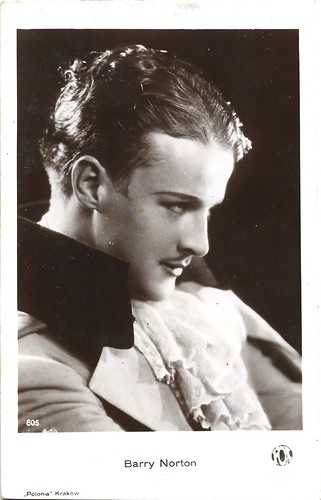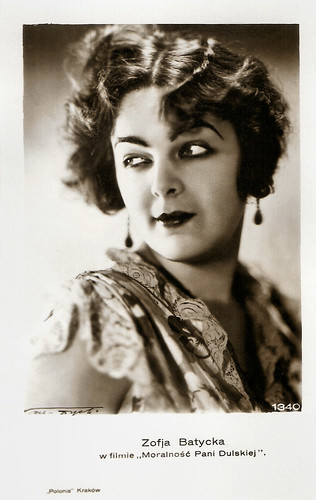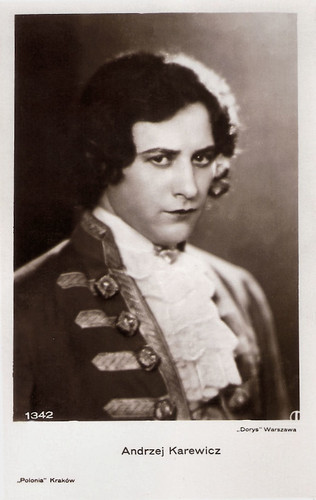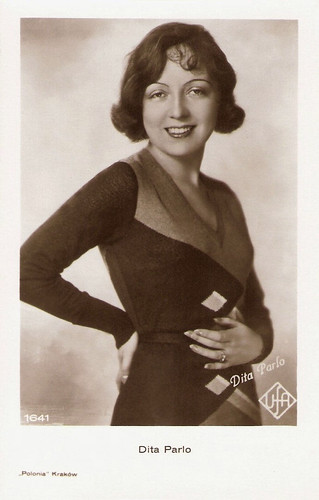
Polish postcard by Polonia, Krakow. Jadwiga Smosarska in Tredowata/The Leper (Boleslaw Mierzejewski, Edward Puchalski, 1927).
Jadwiga Smosarska (1898 -1971) was the biggest star of the Polish cinema of the pre-WWII era. From 1919 on, the Polish actress made more than 25 silent and sound films. She also was very successful on stage. When the Nazis invaded Poland in 1939, she fled to the US. In 1970, she returned to Poland.

Polish postcard by Polonia, Krakòw, no. 27. Photo: Dorys, Warszawa (Warsaw). Collection: Didier Hanson.
Jadwiga Smosarska (1898-1971) was the biggest star of the Polish cinema of the pre-WWII era. From 1919 on, the Polish actress made more than 25 silent and sound films. She also was very successful on stage. When the Nazis invaded Poland in 1939, she fled to the US. In 1970, she returned to Poland.

Polish postcard by Polonia, Krakow, no. 452. Photo: Bavaria Film. Olga Tschechowa in the German silent film Diane (Erich Waschneck, 1929).
Dignified German-Russian actress Olga Tschechowa (1897-1980) was one of the most popular stars of the silent film era. She remained a mysterious person throughout her life.

Polish postcard by Polonia, Krakow, no. 455. Marie Prevost in The Rush Hour (E. Mason Hopper, 1927).
Marie Prevost (1898-1937) was a Canadian-born, American silent screen actress. She was excellent in such comedies as Ernst Lubitsch's The Marriage Circle (1924). The end of her life was filled with tragedies.

Polish postcard by Polonia, Krakow, no. 847. Photo: Hom Film. Valerie Boothby in Vererbte Triebe/Inherited Passions (Gustav Ucicky, 1929).
German actress Valerie Boothby (1906-1982) was a popular star of the Weimar cinema in the late 1920s and early 1930s.
One of the most modern rotogravure printing houses in Poland
There is little information on the web about Polonia. Happily, we could contact Polish postcard specialist Marcin Jaroszewicz who mailed us the following info: 'The Polonia Kraków Printing House was one of the most modern rotogravure printing houses in Poland. In addition to postcards, they printed leaflets and other materials, including film programs (a poorly researched topic, I saw 2 items).
Polonia was known for producing postcards. Film postcards were only part of the assortment (including art, monuments, Christmas, New Year, etc.). There is a problem with the numbers, probably all postcards were numbered continuously no matter what the subject was. For example, a Christmas postcard from 1935 had the number 985.
I could not find information about the beginnings of the company. The Polonia shareholders changed frequently. They were already operating in the early 1920s practically until 1939. After the outbreak of the war, the Germans took over the company and subordinated it to Ross Verlag, then already a Nazi-owned firm. After that, nothing was published as Polonia Kraków. After the war, the company did not resume operations; its assets were taken over by the state (like Ross Verlag in East Germany). After 1945, the company 'Film Polski' published postcards for a short time.
Several of Polonia Kraków's film postcards had poor sharpness and should not have been sold. Defective copies are common on the market. There are two hypotheses: either the company could not afford to recall them or the employees sold them unofficially. The first film postcards, although they were created in the 1920s, referred to postcards with theatre actors from the end of the 19th century and seemed outdated.
A postcard of a popular actor in the early 1930s cost 8 groszy, which was the cheapest cinema ticket. Sets of several postcards cost 20 groszy. The company focused on Polish stars. Famous actors like Jadwiga Smosarska, Eugeniusz Bodo and Adam Brodzisz cost more. The collections of the Cinematography Museum in Łódź are large with postcards by Polonia Kraków, Ross Verlag and others.' Ross Verlag Postcards offers an incomplete index of Polonia Kraków film postcards, focused on foreign actors.

Polish postcard by Polonia, Krakow, no. 805. Photo: Fox Film.
Alfredo Carlos Birabén (1905-1956) was an Argentine actor, who had a Hollywood career under the stage name Barry Norton.

Polish postcard by Polonia, Krakow, no. 882. Photo: Ufa. Dita Parlo in Heimkehr/Homecoming (Joe May, 1928).
Dita Parlo (1908-1971) was a popular European film star in the late 1920s and early 1930s. She inspired both Dita Von Teese and Madonna, who used Parlo's name and character from L'Atalante (1934) for her controversial 'Sex' book and 'Erotica' album.

Polish postcard by Polonia, Kraków, no. 907. Photo: Van Dyck.
Polish actor Zbigniew Sawan (1904–1984) starred both in silent and sound films and was also a respected stage actor in his country. He also worked as a theatre director and manager.

Polish postcard by Polonia, Krakow, no. 923. Collection: Joanna.
Polish actor Harry Cort (1905-?) came from a royal dynasty and had a short film career with starring roles in three silent films, 9:25. Przygoda jednej nocy/9:25. Adventure One Night (1929), Halka (1930) and Karuzela zycia/Carousel of Life (1930).

Polish postcard by Polonia, Krakow, no. 1171.
English film and stage actor Clive Brook (1887-1974) worked first in British films and then in Hollywood. The suave, handsome, distinguished leading man is best remembered as Marlene Dietrich’s love interest in Shanghai Express (1932).
Cinema in Poland before World War II
The history of cinema in Poland is almost as long as the history of cinematography. The first cinema was founded in Łódź in 1899 and by the end of the next decade, there were cinemas in almost every major town in Poland. Arguably the first Polish filmmaker was Kazimierz Prószyński, who filmed various short documentaries in Warsaw. He is credited as the author of the earliest surviving Polish documentary titled Ślizgawka w Łazienkach/Skating-rink in the Royal Baths, made between 1894 and 1896, as well as the first short narrative films Powrót birbanta/Rake's Return Home and Przygoda dorożkarza/Cabman's Adventure, both created in 1902.
The earliest surviving feature film is Pruska Kultura/Prussian Culture, produced in 1907 by Mordechaj Towbin. It was only rediscovered in 2000 in the French archive Bois D'Arcy. For censorship reasons - a part of Poland was still occupied by Germany at the time - this film, which denounced the forced Germanisation and persecution of Polish children, could not be distributed in Poland and was sold abroad. Till 2000, the common assumption was that the comedy Antoś pierwszy raz w Warszawie/Antoś for the First Time in Warsaw (1908) started the Polish film industry. The film was directed by George Meyer (real name Joseph-Louis Mundwiller) and starred Antoni Fertner. Unfortunately, this film, which was immediately shown in Paris, is now considered lost forever. After 1908, Polish artists started experimenting with other genres of cinema. Władysław Starewicz made one of the first animated cartoons in the world - and the first to use the stop motion technique, Lucanus Cervus/Piękna Lukanida/Beautiful Lukanida. The film celebrated its premiere in Moscow in 1912.
Another key figure was Aleksander Hertz, a hugely influential producer. In 1906 he co-founded the Sfinks Motion Picture Theatre, which gave in 1909 its name to Poland's first real film production studio. Hertz was a successful director and ‘discoverer’ of many stars, including Pola Negri. In 1914, the then 18-year-old Pola Negri made her film debut for Sfinks in the Polish silent film Niewolnica Zmysłów/Slave of the Senses (Ryszard Ordynski, Jan Pawlowski, 1914). Edward Puchalski, the other popular director of the time, revealed the talent of Lya Mara. By the start of World War I the cinema in Poland was already in full swing, with numerous film adaptations of major works of Polish literature. During World War I the Polish cinema crossed borders. Films made in Warsaw or Vilnius were often rebranded with German-language intertitles and shown in Berlin. Pola Negri gained fame in Germany. Unfortunately, of the eight films Negri made for Sfinks, only extracts from Bestia/The Beast (Aleksander Hertz, 1917) have survived.
After the First World War, the Republic of Poland emerged after more than 100 years of oppression by the German Empire, the Russian Tsar and the Austro-Hungarian Danube Monarchy. Sfinks had to face up to the loss of its two biggest stars: Pola Negri and Lya Mara, who had left to pursue their careers in Berlin. Jadwiga Smosarska became the studio's new star and the biggest Polish film star of the inter-war period. The first woman to direct a film in Poland and the only female film director of the Polish silent film era was Nina Niovilla. She debuted in 1918 in Berlin and then directed her first Polish film, Tamara/Obrońcy Lwowa (1919). In addition to light comedies and other melodramas, the first patriotic films and literary adaptations were also made. In 1928, Ryszard Ordyński directed the first film adaptation of the Polish national epic 'Pan Tadeusz' by Adam Mickiewicz.
The first sound film in the history of Polish cinema was made in 1930 and was also a literary adaptation: Moralność pani Dulskiej/The Morals of Mrs Dulska (Borys Newolin, Boleslaw Land, 1930), based on Gabriela Zapolska's drama. The 1930s were also characterised by commercial successes. Some actors and singers, such as Adolf Dymsza and Eugeniusz Bodo, became national idols, while others, such as the later world-famous Jan Kiepura, launched their careers. There were also attempts to popularise avant-garde film, including by the artists' group START (Stowarzyszenie Propagandy Filmu Artystycznego), founded by filmmakers Aleksander Ford and Jerzy Toeplitz. Between 1918 and 1939, a total of almost 300 Polish films were made. Shortly before the start of the Second World War, there were 68 cinemas in Warsaw alone and over 800 throughout the country.

Polish postcard by Polonia, Krakow, no. 1320. Dina Gralla and Harry Halm in Wer wird denn weinen, wenn man auseinandergeht?/No Use Crying If Your Sweetheart Goes Away (Richard Eichberg, 1929).
Polish-born, German actress Dina Gralla (1905-1994) often appeared as a naïve, sexy dancer in German revues, and in more than 35 silent and early sound films.
Charming actor Harry Halm (1901-1980) was a popular ladies’ man of the silent German cinema. Sound film and the rise of the Nazis broke his career.

Polish postcard by Polonia, Kraków, no. 1337. Photo: Dorys, Warszawa.
Polish actress Irena Gawęcka (1901-1982) was a star of the silent cinema, who made 5 Polish films between 1928 and 1930. Her film debut as Countess Zofia opposite Boleslaw Szczurkiewicz as her father in Szaleńcy/Madmen (1928), which was also the directorial debut of Leonard Buczkowski. In 1929, the successful film was awarded the Grand Prix and the Gold Medal at the Universal Exhibition in Paris.

Polish postcard by Polonia, Krakow, no. 1340. Photo: Van Dyck. Zofia Batycka in Moralność pani Dulskiej (Borys Newolin, Boleslaw Land, 1930).
Zofia Batycka aka Zofja Batycka (1907-1989) was a Polish model and actress. She supposedly had an affair with tenor Jan Kiepura in 1928 but they never married. As a student Zofia made her debut in the silent Sfinks production Grzeszna milosc (Zbigniew Gniazdowski, Mieczyslaw Krawicz 1929), partly filmed at the Tatra Mountains. It was followed by more Polish silent and sound films. Zofia Batycka won the title of Miss Polonia in 1930 and became extremely popular, winning the title of Miss Paramount in 1931. She went to Hollywood but never made another film.

Polish postcard by Polonia, Krakow, no. 1341. Photo: Van Dyck. Zofia Batycka in Moralność pani Dulskiej/The Morals of Mrs Dulska (Borys Newolin, Boleslaw Land, 1930), based on Gabriela Zapolska's eponymous drama. It was the first Polish sound film, shown with a sound-on-disc system. Today, the records are lacking, so only a silent version exists.

Polish postcard by Polonia, Krakow, no. 1342. Photo: Dorys, Warszawa.
Andrzej Karewicz (1894-1969) was a handsome Polish film actor who appeared in six films in his country between 1928 and 1935. In 1930, he appeared in Aleksander Ford's feature debut Mascotte (1930) with Irma Green.

Polish postcard by Polonia, Krakow, no. 1349. Photo: Zoro-Film. Andrzej Karewicz and Irma Green in Mascotte (Aleksander Ford, 1930), scripted by Jerzy Dal-Atan.
Mascotte (1930) was Aleksander Ford's first feature as director. Ford is better known for his post-war documentary Majdanek - cmentarzysko Europy/Majdanek – the Cemetery of Europe (1945) and the fiction films Ulica Graniczna/Border Street (1949), Piątka z ulicy Barskiej/Five Boys from Barska Street (1954) and Krzyżacy/Knights of the Teutonic Order (1960). Yet, he had already made five feature fiction films and several documentaries and shorts in the 1930s before fleeing to the USSR in the late 1930s when WWII broke out. He returned a convinced and stern communist, became head of the government-controlled Film Polski, and was for 20 years a professor at the famous Lodz National Film School. During the 1968 Polish crisis, and the rising anti-Jewish sentiments, the Jewish Ford fled the country. Blacklisted and publicly silenced by the communist government and unable to produce successful films abroad, he committed suicide in a Florida hotel in 1980.

Polish postcard by Polonia, Krakow, no. 1362. Photo: Universal.
Blonde and utterly beautiful American actress Mary Nolan (1902–1948) appeared on stage, on screen, and most of all in the tabloids. After a 'sex scandal', she fled to Germany where she starred in 17 silent films under her real name, Imogene Robertson.

Polish postcard by Polonia, Kraków, no. 1403. Photo: Paramount-Film. Publicity still for Tajemnica Lekarza/The Doctor's Secret (Ryszard Ordynski, 1930).
Polish actor Zbigniew Sawan (1904–1984) starred both in silent and sound films and was also a respected stage actor in his country. He also worked as a theatre director and manager.

Polish postcard by Polonia, Krakow, no. 1407. Photo: Paramount-Film. Marja Gorczynska was the female star of Tajemnica lekarza (Ryszard Ordynski, 1930). The film was shot at the Paramount Studios near Paris. It was one of the eleven alternative language versions of The Doctor's Secret(William C. de Mille, 1929), based on J.M. Barrie's play 'Half an Hour', and all shot at Paramount in Paris. In the original American version, Ruth Chatterton was the female lead.
Maria aka Marja Gorczynska (1899-1959) was a Polish film actress, known for Tajemnica lekarza (1930), Co mój maz robi w nocy/What Is My Husband Doing at Night? (Michal Waszynski 1934), and Druga mlodosc/Second Youth (Michal Waszynski, 1938).

Polish postcard by Polonia, Krakow, no. 1641. Photo: Ufa.
Dita Parlo (1908-1971) was a popular European film star in the late 1920s and early 1930s. She inspired both Dita Von Teese and Madonna, who used Parlo's name and character from L'Atalante for her controversial 'Sex' book and 'Erotica' album.
Sources: Alain Pavelin (Senses of Cinema), Wikipedia (English, German and French), and IMDb.
With special thanks to Marcin Jaroszewicz, Łukasz Biskupski and Michał Pabiś-Orzeszyna.
No comments:
Post a Comment